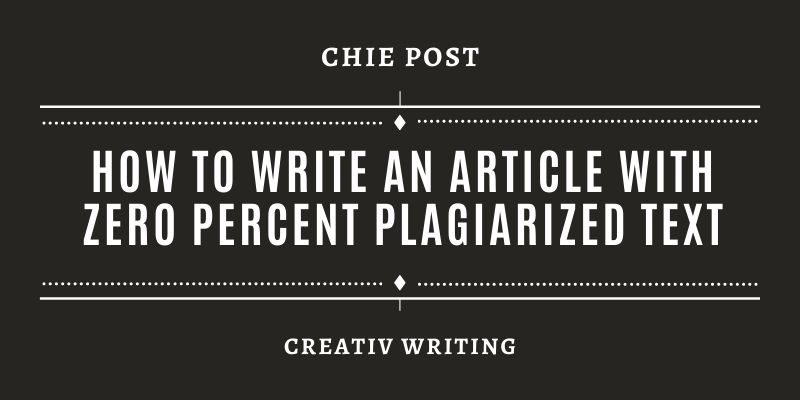Nowadays, every one of us has to write some text for social media blog for business. So so one has to produce a lot of content, most of the time people of fun copy text from one website and publish as their own. However, now search engines are wise enough they can easily attach that this content is already published in somewhere on the web. So, chances to rank on the front page of Google became impossible. If you are writing articles for the sake of SEO then you should keep in mind that writing or publishing plagiarized stuff don’t add up anything in this journey. in this article, I will tell you how you can write a great article without any plagiarized text in it.
Writing anything on any topic requires only knowledge and sun facts and figure which will sport your arguments. if you are not aware of the certain topic then it is a wise approach just scheme through a certain web page and have some common understanding about the topic. After understanding the basic concepts of the topic it is time to start writing.
It is entirely up to you how you are willing to write, some people feel comfortable while writing on the paper some people on the computer, on the other hand, there are certain people who often right on mobile devices such as tablet iPad or mobile phone. However, nowadays I am writing on my mobile phone using Google docs. Interestingly it is the finest way to write your thoughts.
How do I write articles for my blog
I use gboard keyboard on my mobile phone which has a future where I can speak and the spoken word will be converted into textual form. It is the finest to write on good days without having much difficulty. meaning I have had to rewrite a few words manually through the keyboard. but with experience, the frequency of mistakes are decreasing and I can write it is an article in much less time as compared to the traditional methods.
Another benefit of writing on a mobile phone is one can write on the way for instance whenever you are in the metro or travelling you can just type your thoughts through the keypad. and later on, publish on your blog on share it with other friends to social media.
Writing text with zero light reasons is quite a difficult task because of most of us after grabbing some lines from already written articles documents and research papers. Which will further increase the chances of plagiarism? So file writing never looks for other sources not even try to copy a single phrase.
Why plagiarized text will not help in SEO
Google the well-known search engine uses many factors to rank the website on the first page of the search engine against any query. If you have written a great number of articles with a lot of information, it is hoped that they will track on the front page of Google against that respective query. but if the text is light Christ you ka you have compared some or most of the text from other sources. Then your website will not come on to the front page of the search engine. so it is wise to avoid the plagiarized text in any context, either it is a text image or video.
As technology improves search engines and other publishing platforms are using artificial intelligence to detect the plasm from thousands of millions of books, articles and research papers. it is easy to detect let’s listen and punish the publisher.
Selection of topic
Selection of topic is also very important, one just has to write down the domain in which one is going to write in the article a research paper. after deciding the topic one should narrow down his approach in which dimension one is going to write the essay the article. Further one has to to be specific while writing. So here we are only boring the Kita the rest of the title introduction body paragraphs and the conclusion should be our own words. Undoubtedly it is a difficult exercise, what it is not impossible; one can master it through practice. There is a saying, practice makes a man perfect.
How to support your arguments
normally people believe in all the things spoken written by said by well-known authors. Like democracy cannot be explained without quoting Karl Marx. Hindi spray one has to prove his stands with well-known authors researches and entrepreneurs. Search for your topic and select quotations add into your particles which will sport your arguments.
How to be sure that your text is not plagiarized
These days many tools are available on the web free and premium which will help you to check the plagiarism of your content. but if you write it yourself you can tell it how much pleasure is taxed in it on your own. If someone else wrote an article for you when it is wise to check before you publish it on your blog or any other publishing site or added into your research paper.
Grammarly is a well-known tool to check the grammar spelling as well as ledger Azam before you publish your document on any news journal website are blog. There are certainly other tools which you can also use. However, Grammarly has millions of pages database so you can trust in their statistics.
Conclusion
Writing quality content with zero per cent plagiarism requires time effort ads knowledge. One should outline and write your thoughts according to that. The articles are written with the perspective to increase our boost the SEO should not be plagiarized. Every line even phrase should be your own words, in your sequence. In this way, your website will rank on the front page of Google with 0% plagiarism.
Thank you for reading up to the end. If you still have any question or suggestion, please let me know in the comments section. I will respond to you as soon as possible.
JazakAllah


